Full Auto 2: Battlelines - Cars 'n Guns Profile Part 2
Sega shows off some more rides and weapons from its upcoming vehicular combat game for the PlayStation 3.
Currently scheduled for release in North America alongside the PlayStation 3 hardware on November 17, Full Auto 2: Battlelines is the sequel to the Xbox 360-exclusive Full Auto. The upcoming game promises to build upon its predecessor with numerous gameplay tweaks, as well as the addition of new multiplayer modes, new vehicles, and new weapons. Sega and developer Pseudo Interactive recently sent over a ton of information on some of the new toys that you'll be playing with in the game and some of the improvements being made to the game for the PS3. So, without further ado:
PS3 Improvements for Battlelines
Destruction
With all of the new environment updates, we have been spending an extensive amount of time making destruction work more for the player. We started with the basics that worked in Full Auto, which we grew to love, and built outward from there. Propane tanks and ambient cars became a staple of the last game, so with FA2 we tried to outdo ourselves with bigger and more spectacular destruction moments.
Why use a single propane tank to cross the road and take out a player when you can bring down a whole build to crush your pursuers? In every level, we have added more layered destruction--from large oil drums to more explosive traffic. When it comes to the new arena tracks, we were able to empower the players with course-altering destruction elements that promote exploration and new experiences without sidelining the main focus: combat.
Audio
For FA2, we created a bunch of new weapons and six new cars for the game. For us, the main and subcharacters in Full Auto are personified as cars and the weapons you load on to them. These characters need their own distinct voices and personalities. They have to be visceral and satisfying for the player. And as an extra bonus, creating distinct personalities allows you to create texture, tonality, and dynamics within the sonic mix. And you still want to remain true to the real world. For example, a car should sound like a car, and all of the weapons should sound close to their real-world counterparts while exaggerating their kinetic power and energy for the gameplay experience. Sony opted for tilt instead of rumble on its PS3 controllers, which means audio needed to really sell the feeling of getting hit and hitting your enemy. We had this in Full Auto, but the experience was too buried. In FA2, we pushed it further--from the launch of the weapon to its flight and subsequent impact--and I would like to explore this even further in future games.
The tricky part is doing all of this in a combat racing game where everyone is driving, shooting, exploding, and colliding while buildings and various other structures are tumbling all around you. If you play a deathmatch event, you will see and hear what we mean. Speaking of which, in career mode, some of the events take place in a deathmatch arena. You are up against a rival who blares his theme (licensed music) from his car. The only music you will hear in a career deathmatch event that also features one of the uber-boss rivals will be diagetic music. The music comes from the rival's car and is situated in 3D space. If you succeed in killing the rival, then the music also dies, and you are in a world of sound design. But don't worry--the world will still be full of sound. You won't feel lonely.
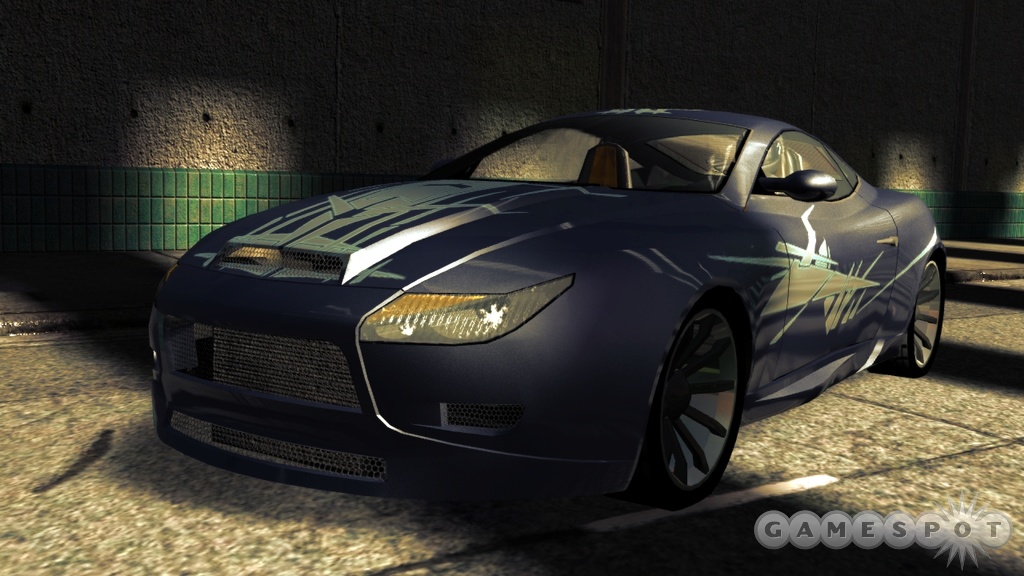
Vehicle Visual Upgrades
There are several systems and techniques that we have upgraded for Full Auto 2 to improve the look of our cars when they are pristine and shiny, but also when they've been smashed to pieces. All of the cars in Full Auto 2, including the ones brought over from the first game, benefit from these new systems.
Enhanced Car Paint Shader--Perhaps the greatest enhancement to the look of the cars in Full Auto 2 is the creation of a new, custom-built car paint shader. This new system gives the cars more realistic reflections, better lighting and shadows, richer and more varied colors, and such multiple paint types as matte, clear coat, and metal flake.
Remodeled Wheels for More Geometry Detail--For Full Auto 2, the wheels on all of the cars were re-created from existing high-resolution geometry so that the rims are fully 3D geometry instead of planes that rely on large normal maps for detail. This greatly improves the look of the wheels.
Remodeled and Retextured Engine Parts--The engine parts under the hood are often seen up close when the player is in hood cam, and they take enough damage for the hood to break off. For Full Auto, these parts were not built with an adequate level of detail for this view. For Full Auto 2, we have created three new high-detail engine configurations, which are customized to fit snugly in each car chassis.
Third Skins for More Customization--All of the rival and challenger cars in Full Auto 2's career mode were given their own custom paint jobs to match the character of that rival. Once the player defeats a rival in the career mode, he can unlock that skin for his own use in solo and multiplayer games.
Car Damage System Upgrades
One of the core pillars of Full Auto was the car destruction system. For Full Auto 2, we wanted to push the car destruction gameplay experience even further. We enhanced several aspects of the destruction system to achieve this goal.
Destroyable Engine Components--In Full Auto 2, we brought the system that we use for blowing large chunks out of buildings to destructing the insides of the cars. Now when a car is destroyed, all of the lovingly modeled engine, transmission, and suspension parts break up and spill onto the asphalt.
Extra Vehicle Debris--For Full Auto 2, we wanted to exemplify the violent forces that occur when large pieces of cars are ripped from their sockets. To do this, we added extra particle effects that are spawned at the locations where parts detach.
Scorch Damage Texture--One of the biggest limitations of the original Full Auto damage-texture system was that regardless of which event (collisions, explosions, rockets) caused damage to the car, the damage texture that appeared was the same. To fix this problem in Full Auto 2, we created an additional damage-texture layer that responds only to explosion and fire damage. The cars now have an extra crispy, bubbly, flaky paint job in those areas that were exposed to the heat of combat.
Enhanced Crumple Map--We have refined the crumple-map damage system so that it is more specialized and acts as a car collision and deformation damage texture. Creating this enhanced effect was done by adding new scraped paint shaders and building on their effects.
Better Broken Glass--Full Auto's glass-damage textures were made with mass production in mind. In Full Auto 2, we created a much more believable broken-glass texture and made it customized to fit on each individual car. In addition, we created some excellent glass-shattering particle effects that are specifically for car windows.
FEM Car Deformation System--This is the procedural physics-based deformation system, which is at the core of our car destruction. In Full Auto, we were limited to how far we could push the potential for car model destruction because of such gameplay limitations as the necessity of maintaining a fully drivable car chassis all the way to the car's demise. In the original game, we generally erred on the side of caution and stiffness with the use of deformation. To overcome this problem in Full Auto 2, we created a system that varied the deformation stiffness of different regions on the cars. The number of hit points that remained on a car's armor facing determined this variation. In this way, we were able to ensure that a player's car would maintain a drivable geometry while it was still alive. It also allowed the player's car to become a complete pretzel in case of a fatal collision.
Cars
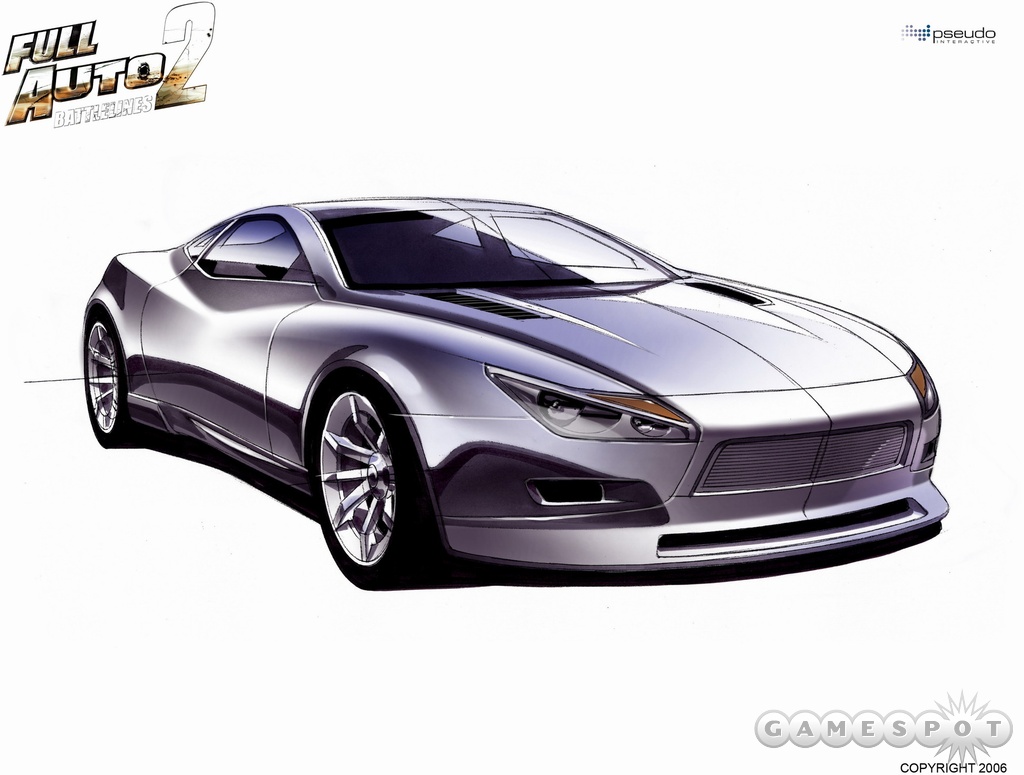
The embodiment of luxury and speed, the Sceptre's sleek and curvaceous form is British styling at its finest. This, combined with its stable and durable chassis, makes the Sceptre a surprisingly practical and versatile automobile. The Sceptre is the supercar that likes to fight. The Sceptre's key advantage is that it is the only A-class car that can mount dual-front weapons. As with all of the A-class cars, it has breathtaking acceleration and great handling. Its Achilles heel is a small boost tank. But who needs boost when all of your opponents are shrapnel anyway?
Sidewinder
The 1978 Sidewinder is a cousin to the classic Vulcan pedigree. If you take an updated and improved Vulcan chassis and give it a new body with a unique and intimidating style, you create the unforgettable Sidewinder. In terms of theme and performance, we wanted the Sidewinder to be the "yin" to the Vulcan's "yang." The cars have the same top speed, armor, and weapons capacity. The Sidewinder has more boost and better midrange acceleration, but the overall handling is looser because of its longer wheelbase, while the Vulcan has better traction and better brakes.
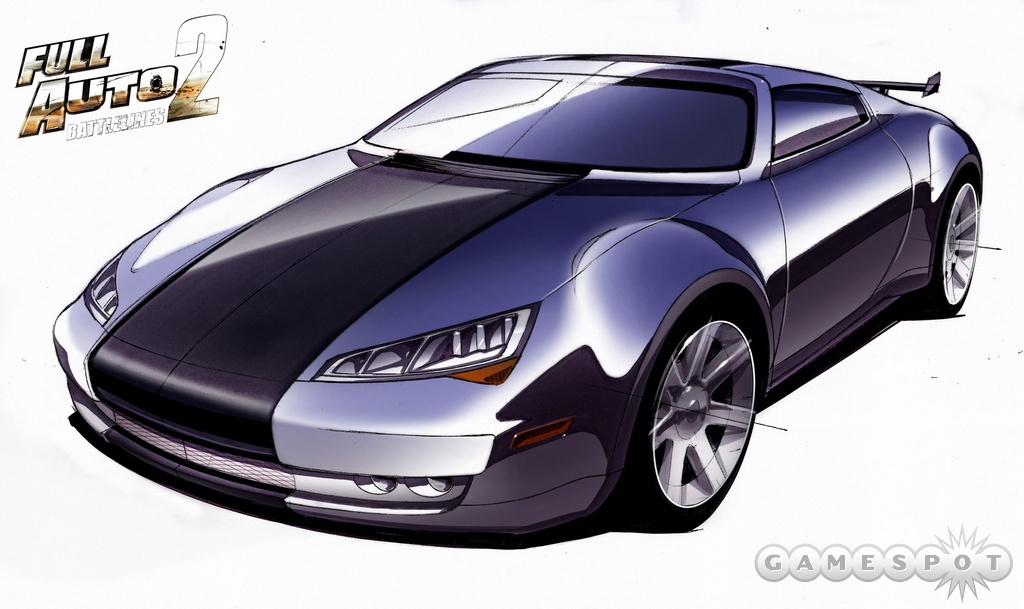
The result of German precision aerodynamics and automotive engineering, the Kinetik is all about business when it comes to speed. Its unique rear-engine design and classic large spoiler make its cornering capabilities second to none. "Speed with control" is the key mantra of the Kinetik. Snug, responsive handling, with great midrange acceleration and a generous boost tank, this car performs equally well in deathmatch or race environments. Expect to see the Kinetik at the front of the pack more often than not.
Executioner
This vehicle is the result of engineering that focused squarely on the goal of creating the ultimate high-speed combat vehicle. The appearance of the Executioner will startle an uninitiated observer. The Executioner exists at the point where the goals of maximum speed, maximum durability, and maximum combat effectiveness converge. The Executioner is the new "ultimate" car for Full Auto 2. It has superior handling, more boost capacity, and a higher top speed when compared with its predecessor, the Warlord. The only brim it tips to the Warlord is acceleration.
Weapons
20mm Cannon 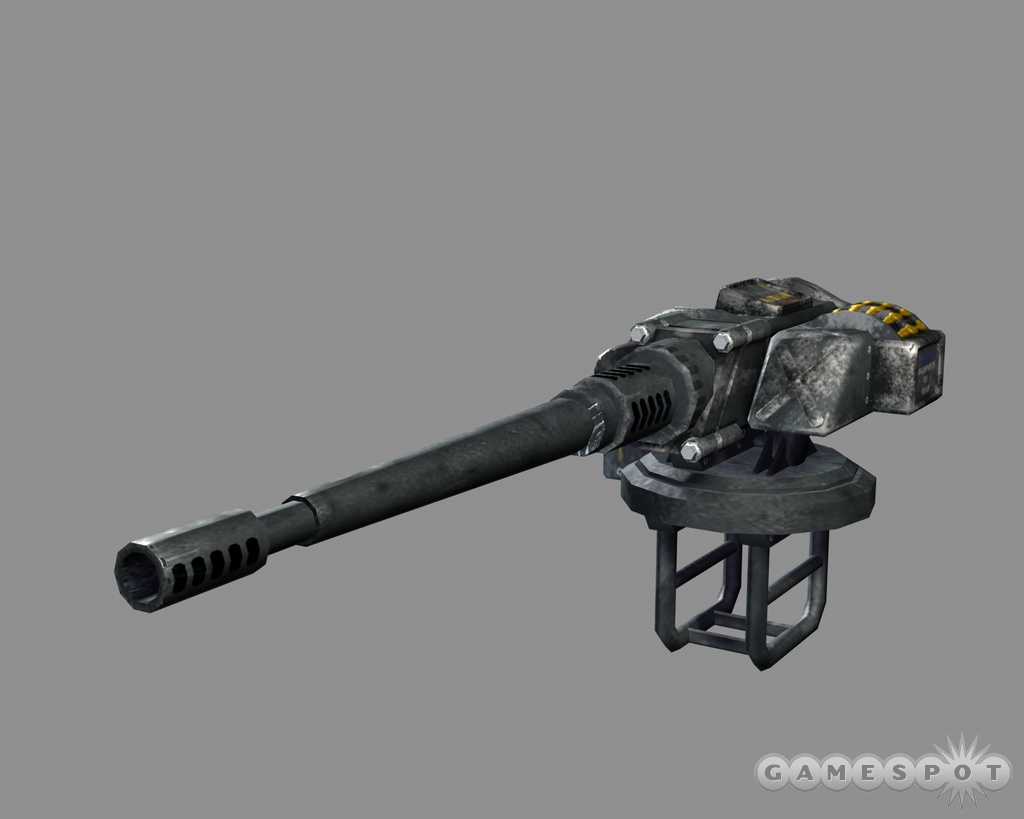
Mount: Front
Description: This is actually not a cannon but a very heavy machine gun. It would be like a cross between a forward grenade launcher and a machine gun--large, explosive-tipped bullets fired as with the MG, albeit at a much slower rate. This weapon is commonly seen mounted on aircraft and, most notably, is the primary mount on the Bradley APC.
Design Goals: This weapon offers new satisfaction because it provides the same firing pattern that MG users are accustomed to, but with a heightened damage/firing rate. The challenge in using this weapon arises from having to adjust to a lower rate of fire for tracking targets and managing an increased overheat capacity.
Available: Complete Chapter 3 (Hookzilla Boss)
Twin Rifle (aka Recoilless Rifle) 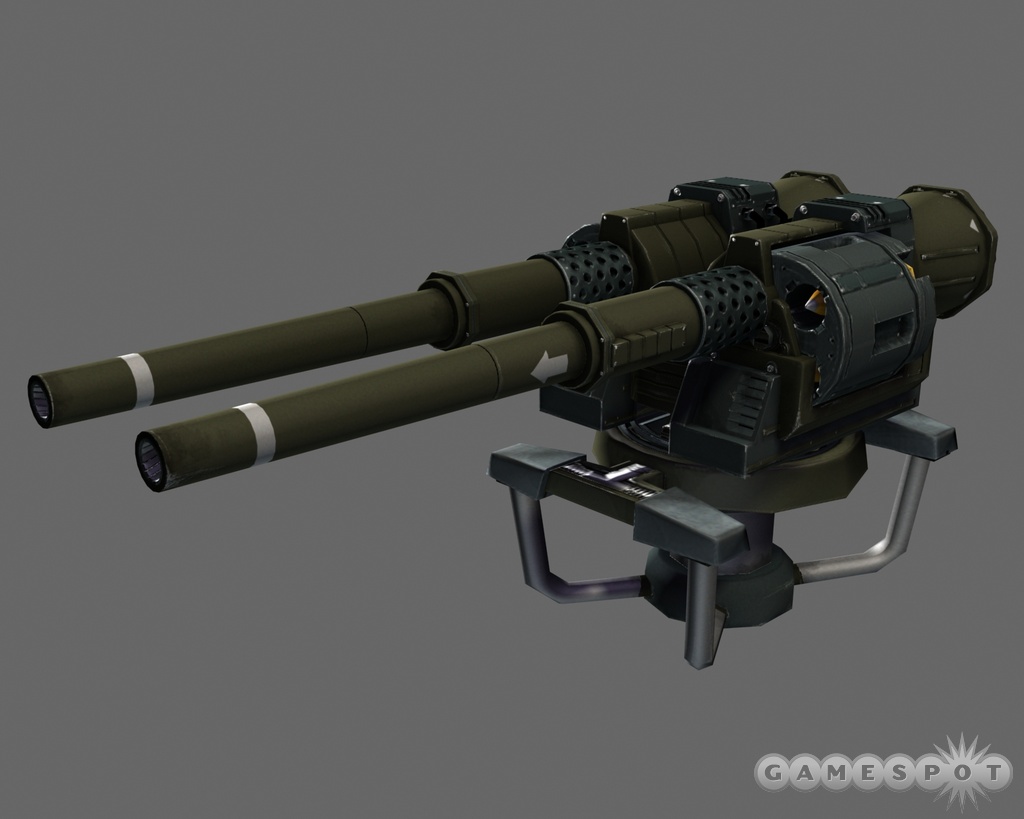
Mount: Front
Description: The recoilless rifle is a real weapon that is designed to allow smaller, lighter military vehicles the ability to fire large antitank projectiles. Typically, only tanks fire these because of recoil.
Design Goals: In effect, the RR would replace the cannon from Full Auto and also add a higher rate of fire while losing some of the Full Auto cannon damage and aim. The RR creates room for the current cannon to evolve into the "rail gun" functionality. Available: Complete Industrial Side Plot 1 (Roughneck Boss)
Got a news tip or want to contact us directly? Email news@gamespot.com
Join the conversation